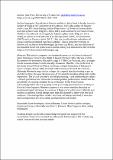Files in this item
Parisian Palimpsests and Creole Creations : Mme Marsan and Dlle Minette play Nina on the Caribbean Stage
Item metadata
| dc.contributor.author | Prest, Julia | |
| dc.date.accessioned | 2020-10-19T23:38:35Z | |
| dc.date.available | 2020-10-19T23:38:35Z | |
| dc.date.issued | 2019-03-20 | |
| dc.identifier | 257463400 | |
| dc.identifier | 09dc398a-2dd0-45c2-971f-b8b14d7cbca3 | |
| dc.identifier | 85063318200 | |
| dc.identifier | 000510665200006 | |
| dc.identifier.citation | Prest , J 2019 , ' Parisian Palimpsests and Creole Creations : Mme Marsan and Dlle Minette play Nina on the Caribbean Stage ' , Early Modern French Studies , vol. Latest Articles . https://doi.org/10.1080/20563035.2019.1592813 | en |
| dc.identifier.issn | 2056-3035 | |
| dc.identifier.other | ORCID: /0000-0002-3266-7390/work/55643795 | |
| dc.identifier.uri | https://hdl.handle.net/10023/20801 | |
| dc.description | The author acknowledges the generous support of The Leverhulme Trust, who awarded a Research Fellowship in 2017-18. | en |
| dc.description.abstract | This article compares the theatrical careers in the French colony of Saint-Domingue (present-day Haiti) of two performers: Mme Marsan, a white European who dominated the public stage in 1780s Cap-Français, and a younger Creole woman of mixed racial ancestry, known as ‘Minette’, who performed in her home town of Port-au-Prince. Its focus is on performances of Dalayrac’s opéra-comique, Nina (1786), in which both women performed the lead role. Although Minette is regarded as a singer, it is argued that, by electing to put on and star in Nina, she was taking on one of the most demanding acting roles in the repertoire. The article considers the self-positioning – and positioning by others – of both performers in relation to the metropolitan performance model and the possibility of creating creolized forms of theatre. While Mme Marsan acknowledged that she was playing a role previously performed successfully in Paris by Mme Dugazon, Minette’s approach was more complex: drawing on unacknowledged references to a review of Dugazon’s performance, Minette also invoked a common Creole background that she claimed to share with her local audience. The metropolitan ‘model’ was thus not always imitated; it was also used as inspiration for new, subtly creolized forms of theatre. | |
| dc.format.extent | 19 | |
| dc.format.extent | 334721 | |
| dc.language.iso | eng | |
| dc.relation.ispartof | Early Modern French Studies | en |
| dc.subject | Saint-Domingue | en |
| dc.subject | Colonial theatre | en |
| dc.subject | Creole theatre | en |
| dc.subject | Opéra-comique | en |
| dc.subject | Female performers | en |
| dc.subject | Mme Marsan | en |
| dc.subject | Minette | en |
| dc.subject | Mme Dugazon | en |
| dc.subject | Nina | en |
| dc.subject | Acting technique | en |
| dc.subject | PN2000 Dramatic representation. The Theater | en |
| dc.subject | DAS | en |
| dc.subject.lcc | PN2000 | en |
| dc.title | Parisian Palimpsests and Creole Creations : Mme Marsan and Dlle Minette play Nina on the Caribbean Stage | en |
| dc.type | Journal article | en |
| dc.contributor.sponsor | The Leverhulme Trust | en |
| dc.contributor.institution | University of St Andrews. Centre for the Public Understanding of Greek and Roman Drama | en |
| dc.contributor.institution | University of St Andrews. French | en |
| dc.identifier.doi | https://doi.org/10.1080/20563035.2019.1592813 | |
| dc.description.status | Peer reviewed | en |
| dc.date.embargoedUntil | 2020-10-20 | |
| dc.identifier.grantnumber | RF-2017-053 | en |
This item appears in the following Collection(s)
Items in the St Andrews Research Repository are protected by copyright, with all rights reserved, unless otherwise indicated.

